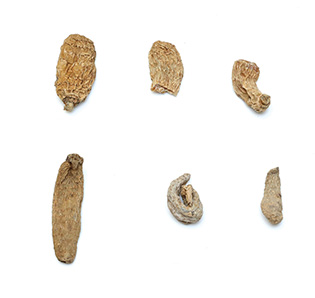
Ganoderma
Researchers developed a novel method to rapidly authenticate and differentiate the types and origins of Chinese medicines.

Adopting the direct ionisation mass spectrometry method, Dr Yao Zhong-ping is able to detect the major active components in Chinese medicine samples and authenticate genuine and counterfeit species in just 10 minutes.

Wild types (upper row) and cultivated types (lower row) of Gastrodiae Rhizoma differ significantly in their curative effect.
Traditional Chinese medicines (TCMs) have an authentication problem. Constituting the major part of a global herbal medicine market valued at over US$70 billion, they are beset with counterfeits, adulteration and confusion about geographical origins. Conventional authentication methods are effective, but they are also time-consuming and complex.
In an effort to meet this challenge, a research team led by Dr Yao Zhong-ping at the Food Safety and Technology Research Centre under the Department of Applied Biology and Chemical Technology developed a new and more effective method of authenticating TCMs using direct ionisation mass spectrometry (DI-MS). DI-MS has previously been used in areas such as food and biomedical analysis, but never before on TCMs.
The team tested the method with Ganoderma and Gastrodiae rhizoma, which are among the most popular and valuable genera of TCMs. Ganoderma species officially described in Chinese Pharmacopoeia are frequently confused with similar-looking species with no known pharmacological efficacy, and authentic Gastrodiae rhizoma species are easily counterfeited. In addition, wild and cultivated types of these TCMs, as well as species with different geographical origins, can differ significantly in curative effect.
Compared with the conventional five-part fingerprint chromatography process that cannot directly analyse raw samples, the DI-MS method is far less labourintensive and time-consuming. The research team used the method to detect the major active components in 52 raw samples of Gastrodiae rhizoma and 43 raw samples of Ganoderma. The surface of each sample was loaded with solvents, and a high voltage was directly applied to a small piece of the sample, inducing spray ionisation and generating mass spectra that revealed the major active components.
This process only takes about 10 minutes to unambiguously differentiate between genuine and counterfeit samples based on their active components. Combining DI-MS with statistical analysis also allows the easy differentiation of wild and cultivated species, and species of different geographical origins.
The research findings, published in the prestigious international chemistry journal Analytica Chimica Acta, indicated that DI-MS is capable of directly and effectively analysing raw samples. It not only has the potential to enhance the TCM industry, but, as Dr Yao stated, “can be further extended to analyse other herbal medicines” and even applied in other fields, as no specialised equipment is required.
